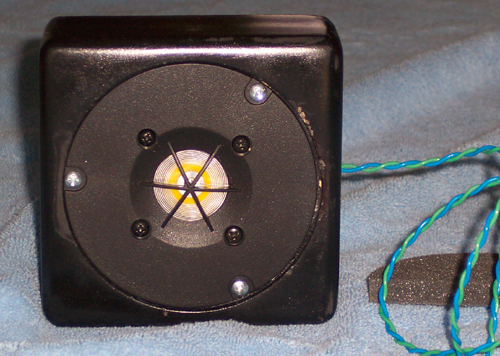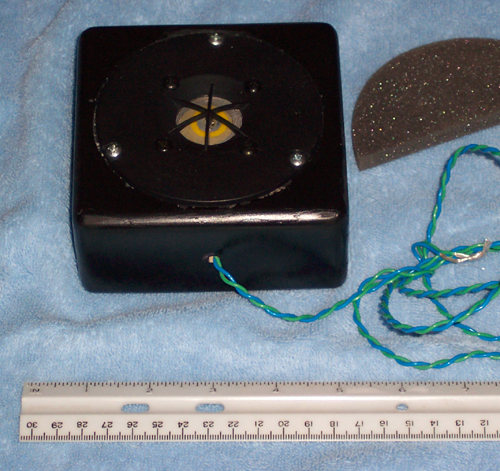
You are reading the older HTML site
Positive Feedback ISSUE
may/june 2008
vmps
Ambiance Tweeter
as reviewed by Roger S. Gordon

|
Ambiance tweeters have been around for years. Many different manufacturers have built them into the back of their speakers. Other manufacturers have been sold ambiance tweeters as free-standing, after-market devices. It is this free-standing, after-market device that is the concern of this article. Typically, these free-standing ambiance tweeters have been simple devices. They usually consist of a tweeter or a super tweeter in a small enclosure. The bottom end of the tweeter rolls off somewhere between 5-10kHz while the top end goes over 20kHz. The ambiance tweeter enclosure usually has a pair of 1.0-1.5 m wires coming out of it so that you can attach the ambiance tweeter directly to the binding posts on the back of your speaker. Because of the long wires you have considerable freedom in positioning the ambiance tweeter. This means the output from the ambiance tweeter can be bounced off of the front wall, the ceiling, the side walls or even beamed directly at the listener. Each position will sound different. General rules of thumb are that aiming the ambiance tweeter off of the ceiling will increase the height of the soundstage. Aimed off of the front wall the depth of the soundstage will increase. Aimed off of the sidewalls, the width of the soundstage will increase. Aiming the ambiance tweeter directly at the listener can compensate for a very dead room that rolls off the treble.

Over the years I have heard a number of freestanding, after-market ambiance tweeters. While functionally similar to one another, they were all different. Some were fairly simple while others had complicated crossovers and sophisticated volume controls for level matching with the main speakers. Some after-market ambiance tweeters had drop dead gorgeous enclosures so you could place them in plain sight on top of your main speakers. Others were best hidden from sight. My perception was that while all of these ambiance tweeters made an improvement to the sound, the units were relatively expensive for the amount of improvement. Because of what I felt was a poor cost/benefit ratio I never acquired an ambiance tweeter to use in my own system. In February 2008 VMPS Audio announced an ambiance tweeter for an introductory price of $169 per pair (which has since been raised to $249). At that price I just could not resist and ordered a pair.
The specifications for the VMPS Ambiance tweeters are as follows:
-
The enclosures are simple, black boxes 4" x 4" x 1.5"
-
The tweeter is a spiral ribbon tweeter that is the basic tweeter used in VMPS speakers
-
Crossover is 12dB/octave at 5kHz using a single capacitor
-
Sensitivity is 88dB/1w/1m
-
Impedance is 20ohm
-
Wiring is 4 feet of 20 gauge teflon silver-plated copper
-
Terminations of your choice are supplied (spades, bananas, rings), but you have to solder the terminations on yourself
-
Volume control is via a half circle of 3/8" thick grey foam which can be attached by double-stick tape to the front of the tweeter
Installation is simple. I had ordered mine with ring terminators. However, when they arrived I did not bother to solder the rings onto the ends of the wires. I just wound the bare ends of the wires around the terminal posts on the back of my speakers, aimed the ambiance tweeters at the front wall and turned on the system. Immediately, I noticed a little more air on the top end and a slightly deeper soundstage. The ambiance tweeters blended perfectly with my main speakers so I did not need to use the grey foam half circles to reduce the output of the ambiance tweeters.

Figuring that the tweeter might need some time to burn in, I left things unchanged for about 20 hours. After the twenty hours I started to experiment by aiming the ambiance tweeters in different directions—front wall, side walls, and ceiling. I also tried positioning the ambiance tweeters behind the speakers, on top of the speakers, and to the inside and outside of the speakers. All the positions sounded different. After much experimentation, the optimum orientation in my system was having each ambiance tweeter resting on top of the speaker, firing at the front wall, toed in towards the center (twenty degrees), and slightly tilted (10 degrees) towards the ceiling. Once this position was determined I had a friend come over and listen to my system with the ambiance tweeters in and out of the system. His comment was that the ambiance tweeters did not made a big difference, but it was a worthwhile difference. He felt the ambiance tweeters should definitely stay in the system and at the current price of $249 were a bargain.
So what were the small, but worthwhile differences that the ambiance tweeters made to my system? First there was a bit more air on top. The ambiance tweeters were injecting additional treble energy into the listening room. This additional treble energy added a sense of spaciousness, of openness to the sound. The additional treble energy give cymbals a slight, additional shimmer. Each strike of a triangle was a bit sharper and crisper. Secondly, the soundstage was few feet deeper and a little bit higher. Nothing major, but it was a noticeable increase. The final difference was in presence. By this I mean the images within the soundstage seemed a little more solid, a little bit more three dimensional, a little more like the real thing.
An ambiance tweeter is not a miracle worker. It will not produce earth shattering sonic changes to your system. However, the ambiance tweeters have been in my system for a couple of hundred hours now and I am not removing them. Over the years I have spent considerable money on all sorts of tweaks. Some have made worthwhile improvements to the sonics of my system and some have not. Based on what these ambiance tweeters did in my system I think they have a very high bang-for-the-buck ratio in comparison to other tweaks that I have tried. Highly recommended. Roger S. Gordon
VMPS Audio
3429 Morningside Dr.
El Sobrante Ca 94803
510-222-4276
web address: www.vmpsaudio.com
